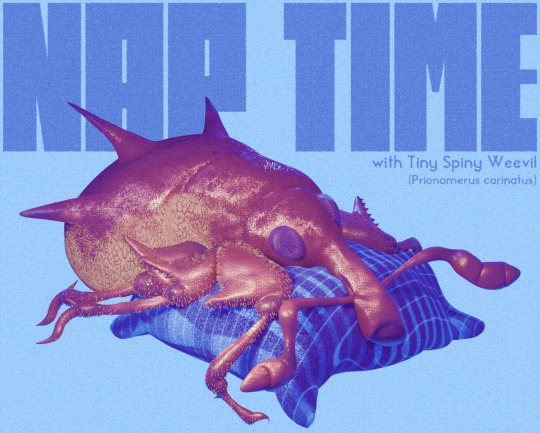#tiny spiny weevil
Text

sleepy weevil
#artists on tumblr#entomology#tiny spiny weevil#prionomerus carinatus#blender#3D modeling#render#cycles#pillow#chronic fatigue#CFS#(honestly bro the only thing I can do other than sleep during a flairup is 3D modeling. it’s just easy IDK)
976 notes
·
View notes
Photo

Spiny Leaf Insect - Extatosoma tiaratum
Having one of these armored insects crawling around on the palm of your hand is a really special experience. Perhaps crawling isn’t the right word, wobbling or swaying is more accurate. As I mentioned in the previous post on this insect, this spiny insect wobbles to mimic a leaf blowing in the wind. This tactic is much more effective while hanging onto a tree branch. Fortunately, we didn’t have any plans to eat this insect. It also was in an arched position as well, trying to keep us away by resembling a scorpion. Using insects like this one, the Hissing Cockroaches and an Annam Walking Stick was a way to introduce first year students to the diversity of insects and showcase how some of the more exotic insects (this one being native to Australia) and how they adapted to the environment. While I’m biased, I think the Giraffe Weevil would be another good insect to showcase, but it lives on the island of Madagascar, so good luck finding one and bringing it in.
The females of this specie are much larger than the males and have sharper spines and armor to protect them. As a trade off however, this makes them heavy, slowing down their movement (no problem) but rendering their already small wings useless (problem?). Males on the other hand get to keep their wings and can use them to fly or scare predators by flashing them. Being able to fly also makes finding mates easier. They receive these wings during their final molt, similar to most adult insects like Cicadas, and just like Cicadas, they like to hang off of branches and greenery while they shed. When the female undergoes her final molt, she retains the curled abdomen and a much more armored shell. Hmmm...it’s possible this Stick Insect was a female and thus kept it’s tail curled for that reason, but I’m not sure this one was done molting; other images of female stick insects show me that they can grow even larger. Fondly enough, they start off as tiny twigs that mimic Ants so predators leave them alone before taking on their arborous look. They’re also remarkably fast while they’re young, slowing down as they gain more armor.
As a final note, if Spiny Leaf Insects can’t find each other at all in the wild, the female can actually lay eggs that are effectively clones of herself. Certainly a useful strategy to help dispersal. I wonder how much influence the phenotype (gene expression through the influence of the environment) has in a situation like this, I mean, for things like color, shape, textures, etc. Stick Insects survive the best when they can all hide among the trees, but the environment has a strong influence over this. Check out some of the different color morphs if you can.
Since these insects technically belong to U of T, I’ve labelled this image with the mantis logo. Pictures were taken on September 19, 2012 within the labs of the University of Toronto with a Samsung Galaxy Glide
#jonny’s insect catalogue#stick insect#spiny leaf insect#macleay's spectre#phasmatodea#phasmid#insect#ontario insect#toronto#september2012#2012#entomology#nature#invertebrates
5 notes
·
View notes
Photo




Date: 1/23/2017
Name: Michael Downs
Class:IDS - H. Audubon
Instructors: Professor Lemeh & Dr Moore
Blog Entry # __1__
Word Count: 307 Pod or Vod cast: No
Reading Assignment: No
Location: Jupiter Arboretum
Time of Day: 9am-11am
Discussion:
For the rounded object in nature homework assignment for the week of January 13-20, I chose southern live oak (Quercus virginiana) acorns that lined the breezeway on campus. They were tapered, glossy, and a gradient from light brown to almost black, especially near the tips. The acorns were ready for germination, as they had fallen off the tree, hardened, and were brown rather than green. They all had a small hole in them, a result of an acorn weevil (Conotrachelus posticatus). I was not able to find one of these, as it had already hatched out.
During class on January 20, my first subject was a spiny backed orb weaver (Gasteracantha cancriformis) found between two branches of a southern live oak tree. The subject was six mm wide, had six red spines, meaning it was a female, as males only have four to five. Its abdomen was white with black areas where the red tips would meet the white. Its web was just above the water reach of the 360 degree sprinklers in the Arboretum.
Next I found several shells on the ground of White Garden Snails (Theba pisana) on the surface level of dirt among the leaves. I first thought they were apple snails, but upon researching I learned that apple snails were literally the size of apples, and these were much smaller. Most were devoid of color, with one having brown in small bands. The shells were around twelve to fifteen mm in diameter, with the shell thickening along the lip of the aperture. The surface of the shell wasn’t glossy, but marked with many tiny, vertical, shallow grooves.
Lastly, I found a small pointed snail shell (Prietocella Barbara) under a stone. The shell was 2 cm in length, conical, off white with grey bands of color and had five whorls.
Sources:
https://www.na.fs.fed.us/spfo/pubs/silvics_manual/Volume_2/quercus/virginiana.htm
http://www.insectidentification.org/insect-description.asp?identification=Acorn-Weevil
http://entnemdept.ufl.edu/creatures/beneficial/g_cancriformis.htm
0 notes